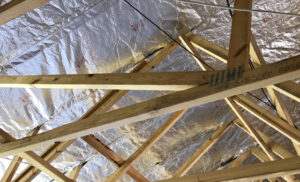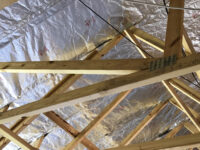How a Radiant Barrier Can Reduce Your Cooling Bills
When properly installed, a radiant barrier can significantly reduce your cooling bills. However, it will still be necessary to add insulation for complete energy efficiency.
Radiant Barrier Houston reduces summer heat gain by absorbing and reflecting radiant energy. They don’t reduce conduction like thermal insulation materials do, but they are very effective at reducing the amount of energy that is required to cool your home.
Radiant barriers are designed to be installed underneath your roofing sheathing, with the foil side facing down. They can be perforated or solid. A perforated radiant barrier has small holes throughout the product that allow moisture vapor to pass through it. It is important to test the product for moisture prior to installing it in order to ensure it is not leaking and has passed the minimum requirements.
The manufacturer of radiant barriers, has set a new standard in foil radiant barriers by making them lighter and stronger than other brands. This makes it easier for contractors to install and more durable. It also has an improved anti-corrosion coating that protects the aluminum from oxidation, which causes it to lose its ability to reflect radiant heat. This coating has passed the newest ASTM fire test.
When installed properly, a radiant barrier will keep your attic cooler and, in turn, cut down on the amount of heat that is transferred into your living space. It will also help keep your air conditioning running more efficiently.
The best way to determine if a radiant barrier will benefit your home is to contact an insulation and radiant barrier specialist. They should be able to give you advice and recommendations that will provide you with the greatest comfort and savings.
Radiant barriers are not a replacement for traditional fiberglass insulation, but they do significantly increase the efficiency of your home by keeping the attic cooler. It is recommended that they be combined with other insulating measures such as air sealing, attic vents, and spray foam insulation. Radiant barriers can save you a significant amount on your cooling costs and can even allow you to cut back on the amount of time that your air conditioner is running.
Reflectivity
Radiant barriers reduce the transfer of radiant heat through an attic by reflecting it back to its source. This keeps the roof cooler and cuts energy costs. Radiant barriers are available in a range of thicknesses and colors. However, not all are created equal. In order to achieve optimal performance, the reflective surface should be as smooth and clean as possible. It’s also important to choose a product that has been tested against the latest standards. A good indicator of quality is the emissivity rating. The lower the emissivity, the better the product will perform.
There are two basic types of radiant barriers: foil-backed plastic and foil-bonded sheathing. The former are thin sheets of plastic (usually the same type as used in water bottles) with a layer of aluminum foil on both sides. The latter is a rigid panel that has a layer of reflective material on one side. A thicker, woven fabric is placed in the middle of the sheathing to give it strength and durability. The higher the woven count, the stronger and more durable the product will be.
While radiant barriers have been around for years—builders and HVAC installers in Sun Belt states have long used aluminum foil sheeting to block some of the sun’s heat gain—they didn’t become widespread until recent decades. Liquid radiation control coatings that can be sprayed or rolled on surfaces, as well as foil-backed sheathing and radiant barrier products, are now available to help homeowners make their homes more energy efficient.
Radiant barriers don’t insulate in the same way as conventional insulation materials rated by their R-value. They prevent heat transfer by reducing the amount of thermal radiation that reaches the attic floor, where conventional insulation is located.
Although they don’t insulate on their own, radiant barriers can be combined with other types of insulation materials and installed in an attic to improve a home’s energy efficiency. Studies have shown that when properly installed, they can significantly reduce air-conditioning costs in hot climates. In combination with other energy-saving construction and design strategies, radiant barriers can contribute up to 30% to cooling energy savings.
Durability
Radiant barriers are designed to withstand the rigors of hot climates. When properly installed in the attic, they can be expected to last for years. This durability extends beyond the lifespan of the product and is a key component in its ability to reduce cooling costs over time.
While many products that claim to be radiant barriers are available on the market, not all are created equal. When evaluating potential choices, it is important to find a radiant barrier that has been tested to meet the latest ASTM standards. This will ensure that the radiant barrier meets all of the necessary criteria and that it is the best choice for your home’s needs.
The effectiveness of a radiant barrier depends on the type of insulation being used beneath it and on how it is installed in the attic. For instance, it is not recommended to place a radiant barrier directly over blown-in insulation, as the insulator will prevent the reflective barrier from performing effectively. The material is also more susceptible to dust accumulation and will require cleaning periodically, thereby diminishing its efficiency.
In addition, it is not advisable to install the radiant barrier in such a way that it faces inside walls or other surfaces where air space is not present. The reflective surface must be able to face outside the home for it to work as an effective thermal control.
When combined with other insulation materials and energy-saving construction techniques, the radiant barrier can significantly reduce cooling bills in homes built in hot climates. In fact, one industry-funded test on OSB with radiant barrier foil over R-30 insulation showed that air conditioning energy savings of up to 30% are achievable.
Unlike other mass insulations, such as fiberglass or cellulose, radiant barriers are not affected by humidity and are therefore ideal for controlling radiant heat transfer year-round. They can also be applied over existing insulation and are a cost-effective alternative to replacing the existing insulation.
In some cases, radiant barriers are pre-laminated to the sheathing or roof decking in new construction to save time and labor costs. This is an excellent method of installation since it can save on the costs of installing the OSB roof and gable-end sheathing while at the same time providing high-quality reflective insulation. In other cases, the radiant barrier is sprayed on or brushed onto the surface of the insulation and is then covered with a sheet of aluminum foil.
Installation
When installed properly, radiant barriers stop more than 80% of the sun’s heat from entering an attic, reducing energy costs. This makes them especially valuable in hot climates, where they can help reduce air conditioning energy use and cut energy bills.
Radiant barriers aren’t insulators and therefore don’t have an R-value, but when combined with other insulating materials, such as fiberglass batt insulation or foam insulation with adequate air spaces between the layers, they can improve the performance of the insulator and help it achieve its intended R-value. Some radiant barrier foils bonded to insulating materials also claim to have an R-value, but it is the air trapped in the insulator that performs the actual insulating functions.
Typically, contractors install radiant barriers in new homes before the roof sheathing is put on, but they can also be installed in existing homes with open attics by using an attic access hatch and stapling the rolled-foil reflective barrier between the rafters. Ideally, the installation of radiant barriers is done by experienced professionals to minimize dust accumulation on the foil surface and ensure that it’s placed properly over the attic’s existing insulation.
The type of radiant barrier you choose depends on the climate in which you live. Some manufacturers of radiant barriers sell products designed specifically for different climate zones. You should always check the product’s label for its specific climate zone information and verify that it will provide the desired results in your area. It is also a good idea to consult with local or state planning authorities for guidance on whether a radiant barrier will be a worthwhile investment.
When purchasing radiant barriers, you should also look for a product that has the highest fire rating available, such as Class A or Class 1, tested under either the ASTM E84 or ASTM E2599 mounting methods. Having the highest fire rating will not only save you money on your utility bills but also protect your home in case of a fire.
Finally, when installing a radiant barrier, you should be sure to purchase a perforated version rather than a non-perforated one. If you install a non-perforated radiant barrier in your attic, water vapors that rise from the house will have nowhere to escape and can cause moisture problems inside your home. The perforated radiant barrier, on the other hand, has tiny holes that allow both air and water vapor to pass through.




